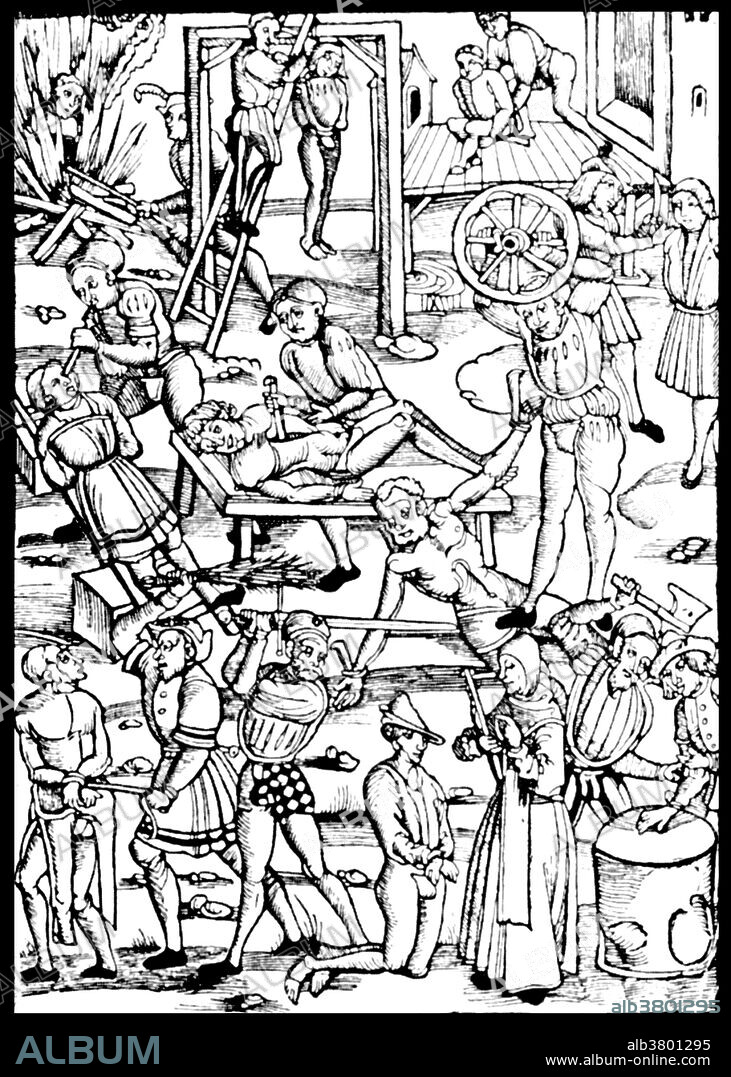alb3801295
Medieval Torture

|
Add to another lightbox |
|
Add to another lightbox |



Buy this image.
Select the use:

Title:
Medieval Torture
Caption:
Medieval and early modern European courts used torture, depending on the crime of the accused and his or her social status. Torture was deemed a legitimate means to extract confessions or to obtain the names of accomplices or other information about a crime, although many confessions were greatly invalid due to the victim being forced to confess under great agony and pressure. It was permitted by law only if there was already half-proof against the accused. Torture in the Medieval Inquisition began in 1252 with a papal bull Ad Extirpanda and ended in 1816 when another papal bull forbade its use. Torture was usually conducted in secret, in underground dungeons. By contrast, torturous executions were typically public, and woodcuts of prisoners being hanged, drawn and quartered, and heretics were burned at the stake show large crowds of spectators. Tortures later in the Middle Ages consisted of whipping; the crushing of thumbs, feet, legs, and heads in iron presses; burning the flesh; and tearing out teeth, fingernails, and toenails with red-hot iron forceps. Limb-smashing and drowning were also popular medieval tortures.
Credit:
Album / NYPL/Science Source
Releases:
Model: No - Property: No
Rights questions?
Rights questions?
Image size:
3104 x 4350 px | 38.6 MB
Print size:
26.3 x 36.8 cm | 10.3 x 14.5 in (300 dpi)
Keywords:
1500S • 1508 • 16 16TH XVI XVITH SIXTEENTH CENTURY • 16 CENTURY • 16TH CENTURY • 16TH • ART • ARTWORK • BEHEAD • BEHEADING • BREAKING WHEEL • BURNED ALIVE • BURNED AT STAKE • BURNED • BURNT • CATHERINE WHEEL • CRIMINAL JUSTICE • CRUEL • CRUELTY • DECAPITATE • DECAPITATION • DRAWING • EXECUTE • EXECUTING • EXECUTION • GALLOWS • HANGING • HISTORIC • HISTORICAL • HISTORY • ILLUSTRATION • ILLUSTRATIONS • IMPALED • IMPALEMENT • INFAMOUS • INHUMANE • INHUMANITY • INTERROGATE • INTERROGATION • JUSTICE SYSTEM • LEGAL SYSTEM • LEGAL • MEDIEVAL • MEN • MIDDLE AGES • PAIN • PENAL SYSTEM • PEOPLE • PERSECUTE • PERSECUTING • PERSECUTION • PHYSICAL PAIN • PRISONER • PUNISH • PUNISHING • PUNISHMENT • PURSUIT • SUFFER • SUFFERING • TORMENT • TORMENTER • TORMENTING • TORTURE DEVICE • TORTURE INSTRUMENT • TORTURE METHOD • TORTURE • TORTURER • TORTURING • VICTIM • VICTIMS • WHEEL, THE • WOMEN • WOODBLOCK PRINT • WOODBLOCK • WOODCUT • XVI CENTURY • XYLOGRAPHY
 Pinterest
Pinterest Twitter
Twitter Facebook
Facebook Copy link
Copy link Email
Email
